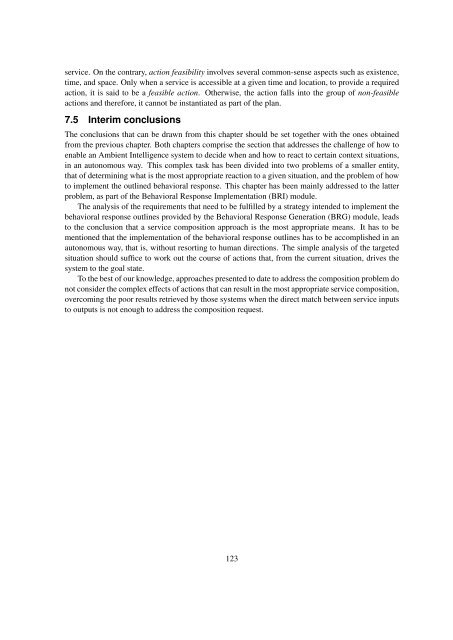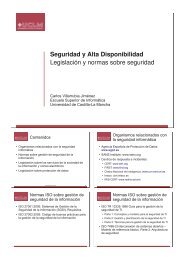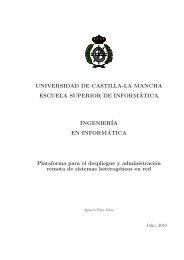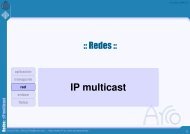MarÃa José Santofimia Romero - Grupo ARCO - Universidad de ...
MarÃa José Santofimia Romero - Grupo ARCO - Universidad de ...
MarÃa José Santofimia Romero - Grupo ARCO - Universidad de ...
Create successful ePaper yourself
Turn your PDF publications into a flip-book with our unique Google optimized e-Paper software.
service. On the contrary, action feasibility involves several common-sense aspects such as existence,time, and space. Only when a service is accessible at a given time and location, to provi<strong>de</strong> a requiredaction, it is said to be a feasible action. Otherwise, the action falls into the group of non-feasibleactions and therefore, it cannot be instantiated as part of the plan.7.5 Interim conclusionsThe conclusions that can be drawn from this chapter should be set together with the ones obtainedfrom the previous chapter. Both chapters comprise the section that addresses the challenge of how toenable an Ambient Intelligence system to <strong>de</strong>ci<strong>de</strong> when and how to react to certain context situations,in an autonomous way. This complex task has been divi<strong>de</strong>d into two problems of a smaller entity,that of <strong>de</strong>termining what is the most appropriate reaction to a given situation, and the problem of howto implement the outlined behavioral response. This chapter has been mainly addressed to the latterproblem, as part of the Behavioral Response Implementation (BRI) module.The analysis of the requirements that need to be fulfilled by a strategy inten<strong>de</strong>d to implement thebehavioral response outlines provi<strong>de</strong>d by the Behavioral Response Generation (BRG) module, leadsto the conclusion that a service composition approach is the most appropriate means. It has to bementioned that the implementation of the behavioral response outlines has to be accomplished in anautonomous way, that is, without resorting to human directions. The simple analysis of the targetedsituation should suffice to work out the course of actions that, from the current situation, drives thesystem to the goal state.To the best of our knowledge, approaches presented to date to address the composition problem donot consi<strong>de</strong>r the complex effects of actions that can result in the most appropriate service composition,overcoming the poor results retrieved by those systems when the direct match between service inputsto outputs is not enough to address the composition request.123
















